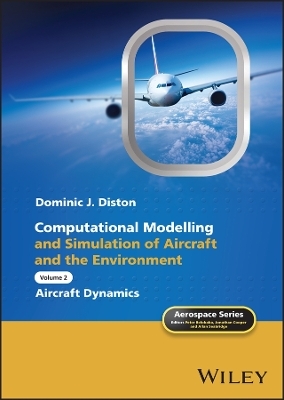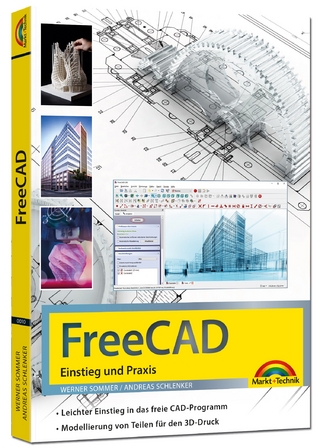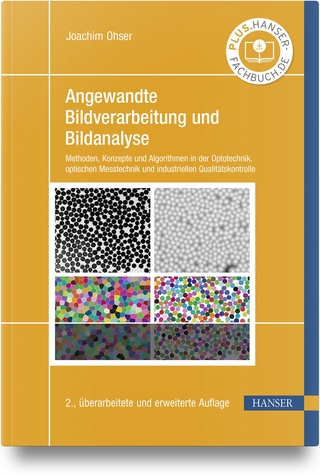
Computational Modelling and Simulation of Aircraft and the Environment, Volume 2
John Wiley & Sons Inc (Verlag)
978-0-470-68711-6 (ISBN)
Computational Modelling and Simulation of Aircraft and the Environment An in-depth discussion of aircraft dynamics modelling and simulation
This book provides a comprehensive guide to modelling and simulation from basic physical and mathematical principles, giving the reader sufficient information to be able to build computational models of aircraft for the purposes of simulation and evaluation. Highly relevant to practitioners, it takes into account the multi-disciplinary nature of aerospace products and the integrated nature of the models needed in order to represent them. Volume 1- Platform Kinematics and Synthetic Environment focused on the modelling of a synthetic environment in which aircraft operate and its spatial relationship with vehicles that are situated and moving within it. This volume focuses on the modelling of aircraft and the interpretation of their flight dynamics.
Key features:
Includes chapters on equations of motion, fixed-wing aerodynamics, longitudinal flight and gas turbines, as well as an opening chapter that presents an overview of flight modelling and a concluding chapter that presents a number of additional topics such as aircraft structures and embedded systems.
Serves as both a student text and practitioner reference.
Follows on from previous Aerospace Series titles, offering a complementary view of vehicles and systems from the perspectives of mathematics, physics and simulation.
This book offers a comprehensive guide for senior, graduate and postgraduate students of aerospace engineering as well as professional engineers involved in the modelling and simulation of aircraft.
Dominic J. Diston was a senior lecturer in aerospace engineering at the University of Liverpool and subsequently associate professor at the University of Nottingham. He also spent 25 years in the aerospace industry and has wide experience in dynamics, control and simulation of vehicles and systems. Major areas of work have included integrated flight/propulsion control, computer-aided engineering and fuel/thermal/power system simulation. All work has been closely linked with projects, most significantly Harrier, Typhoon, Nimrod and F-35.
Preface xi
Aerospace Series Preface xiii
1 A Simple Flight Model 1
1.1 Introduction 1
1.1.1 General Introduction to Volume 2 1
1.1.2 What Chapter 1 Includes 1
1.1.3 What Chapter 1 Excludes 2
1.1.4 Overall Aim 2
1.2 Flight Path 2
1.3 Flight Environment <20 km 5
1.4 Simple Propulsion Model 6
1.4.1 Reference Parameters 6
1.4.2 Simple Jet Engine Performance 7
1.4.3 ‘Better’ Jet Engine Performance 8
1.4.4 Simple Jet Engine Dynamics 10
1.5 Simple Aerodynamic Model 10
1.5.1 Idealised Aircraft 10
1.5.2 Idealised Wing 11
1.5.3 Wing/Tail Combination 13
1.5.4 Lift Distribution 15
1.5.5 Adding Flight Controls 18
1.6 Airspeed Definitions 20
1.7 Flight Model Architecture 21
2 Equations of Motion 25
2.1 Introduction 25
2.1.1 The Problem with Equations of Motion 25
2.1.2 What Chapter 2 Includes 25
2.1.3 What Chapter 2 Excludes 26
2.1.4 Overall Aim 26
2.2 Spatial Reference Model 26
2.2.1 Generic Reference Frames 26
2.2.2 Rotating Reference Frames 28
2.2.3 Elementary Rotations 29
2.2.4 Reference Frames for Position and Orientation 30
2.2.5 Reference Frame for Flight Path 32
2.2.6 Airspeed and Airstream Direction 33
2.3 Aircraft Dynamics 34
2.3.1 Mass Properties 34
2.3.2 Flight Parameters 35
2.3.3 Dynamic Equations of Motion 36
2.4 Aircraft Kinematics 39
2.4.1 Aircraft Position 39
2.4.2 Quaternions 40
2.4.3 Kinematic Equations of Motion 41
2.5 Initialisation 42
2.5.1 Balancing Forces 42
2.5.2 Typical Flight Conditions 44
2.5.3 Finding Aircraft Flight Parameters for Equilibrium 45
2.6 Linearisation 48
2.6.1 Linearisation of Dynamic Equations of Motion 48
2.6.2 Linearisation of Kinematic Equations of Motion 49
2.6.3 Linearisation of Aerodynamic Forces and Moments 50
2.6.4 Linearisation of Propulsive Forces and Moments 51
2.6.5 Linearisation of Gravitational Forces and Moments 51
2.6.6 The Complete Linearised System of Equations 52
3 Fixed-Wing Aerodynamics 55
3.1 Introduction 55
3.1.1 Fixed Wings and Aerodynamics 55
3.1.2 What Chapter 3 Includes 55
3.1.3 What Chapter 3 Excludes 56
3.1.4 Overall Aim 56
3.2 Aerodynamic Principles 56
3.2.1 Aerofoils 56
3.2.2 Dimensional Analysis 58
3.2.3 Lift, Drag, and Pitching Moment 59
3.2.4 Aerodynamic Centre 61
3.2.5 Wing Geometry 63
3.2.6 NACA Four-Digit Sections 64
3.3 Aerodynamic Model of an Isolated Wing 66
3.3.1 Aerodynamic Lift 66
3.3.2 Pitching Moment 68
3.3.3 Drag Force 69
3.3.4 Profile Drag 69
3.3.5 Induced Drag 70
3.3.6 Wave Drag 73
3.4 Trailing-Edge Controls 75
3.4.1 Incremental Lift 75
3.4.2 Incremental Drag 78
3.4.3 Incremental Pitching Moment 79
3.4.4 Hinge Moments 79
3.5 Factors affecting Lift Generation 81
3.5.1 Sideslip 81
3.5.2 Aircraft Rotation 82
3.5.3 Structural Flexibility 83
3.5.4 Ground Effect 85
3.5.5 Indicial Aerodynamics 85
3.6 Lift Distribution 86
3.7 Drag Distribution 89
4 Longitudinal Flight 91
4.1 Introduction 91
4.1.1 Flight with Wings Level 91
4.1.2 What Chapter 4 Includes 91
4.1.3 What Chapter 4 Excludes 91
4.1.4 Overall Aim 92
4.2 Aerodynamic Fundamentals 92
4.3 Geometry 92
4.4 Wing/Body Combination 94
4.4.1 Lift Force 94
4.4.2 Downwash 95
4.4.3 Pitching Moment 97
4.4.4 Aerodynamic Centre 99
4.4.5 Drag Force 99
4.5 All-Moving Tail 101
4.5.1 Lift Force 101
4.5.2 Pitching Moment 102
4.5.3 Drag Force 102
4.6 Flight Trim 102
4.7 Flight Stability 103
4.8 Trim Drag 106
4.8.1 Minimum Drag 106
4.8.2 Relative Speed and Relative Drag 108
4.8.3 Variation of Minimum Drag Speed 110
4.8.4 Minimising ‘Minimum’ Drag 111
4.9 Steady-State Flight Performance 113
4.9.1 Definitions 113
4.9.2 Airspeeds for Maximum Endurance and Maximum Range 113
4.9.3 Range and Endurance 114
4.9.4 Alternative Form for Jet Aircraft Range and Endurance 115
4.9.5 Fuel Required to Carry Fuel 116
4.10 Dynamic Modes 117
5 Gas Turbine Dynamics 123
5.1 Introduction 123
5.1.1 The Importance of Gas Turbines 123
5.1.2 What Chapter 5 Includes 123
5.1.3 What Chapter 5 Excludes 123
5.1.4 Overall Aim 124
5.2 Ideal Gas Properties 124
5.2.1 Equation of State 124
5.2.2 Energy, Enthalpy, and Entropy 125
5.2.3 Specific Heat Capacity 126
5.2.4 Adiabatic Gas Ratio 126
5.2.5 Compressible Gas Properties 127
5.2.6 Polytropic Processes 127
5.3 Gas Dynamics 128
5.3.1 Fundamental Relationships for Gas Flow 128
5.3.2 Speed of Sound 129
5.3.3 Bernoulli’s Equation 130
5.3.4 Stagnation Conditions 131
5.4 Engine Components 132
5.4.1 Duct 133
5.4.2 Junction 134
5.4.3 Compressor 134
5.4.4 Split Compressor 136
5.4.5 Combustor 136
5.4.6 Turbine 137
5.4.7 Nozzle 138
5.5 Engine Dynamics 139
5.5.1 Shaft Speed Variation 139
5.5.2 Massflow Variation 139
5.5.3 Pressure Variation at Constant Temperature 140
5.5.4 Pressure and Temperature Variation 140
5.6 Engine Models 141
5.6.1 Turbojet Engine 141
5.6.1.1 Turbojet Specification 142
5.6.1.2 Turbojet Initialisation 144
5.6.1.3 Turbojet Physics 145
5.6.1.4 Turbojet Dynamics 146
5.6.2 Turbofan Engine 147
5.7 Gas Properties Data 150
5.7.1 Summary of Gas Properties 151
5.7.2 Gas Mixtures defined by Mass Fractions 151
5.7.3 Gas Mixtures defined by Mole Fractions 152
5.7.4 Dry Air 152
5.7.5 Fuel/Air Combustion Products 153
6 Additional Topics 157
6.1 Introduction 157
6.1.1 Expanding the Scope of Volume 2 157
6.1.2 What Chapter 6 Includes 157
6.1.3 What Chapter 6 Excludes 157
6.1.4 Overall Aim 157
6.2 Structural Models 158
6.2.1 Equations of Motion 158
6.2.2 Coordinate Transformations 159
6.2.3 Coupled Structure 161
6.2.4 Wing-Fuselage Structure 162
6.2.5 Whole Aircraft Structure 169
6.3 Mass Distribution 170
6.3.1 Mass Properties 170
6.3.2 Transforming Mass Properties 174
6.3.3 Combining Mass Properties 175
6.3.4 Fuel Mass Distribution 175
Bibliography 183
Index 187
| Erscheint lt. Verlag | 18.4.2024 |
|---|---|
| Reihe/Serie | Aerospace Series (PEP) ; 2 |
| Mitarbeit |
Herausgeber (Serie): Peter Belobaba, Jonathan Cooper, Allan Seabridge |
| Verlagsort | New York |
| Sprache | englisch |
| Maße | 168 x 244 mm |
| Gewicht | 510 g |
| Themenwelt | Informatik ► Grafik / Design ► Digitale Bildverarbeitung |
| Technik ► Fahrzeugbau / Schiffbau | |
| Technik ► Luft- / Raumfahrttechnik | |
| Technik ► Maschinenbau | |
| Schlagworte | Luftfahrttechnik |
| ISBN-10 | 0-470-68711-8 / 0470687118 |
| ISBN-13 | 978-0-470-68711-6 / 9780470687116 |
| Zustand | Neuware |
| Informationen gemäß Produktsicherheitsverordnung (GPSR) | |
| Haben Sie eine Frage zum Produkt? |
aus dem Bereich


